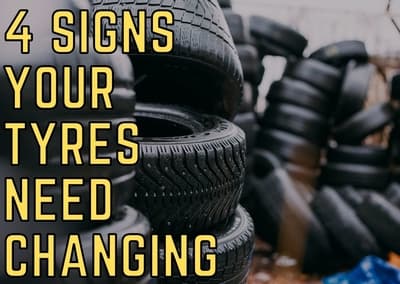4 signs your tyres need changing

Tyres can have a profound effect on the way your car performs. They can influence driving performance, fuel economy and how safe your vehicle is to drive. If you want your car to perform to optimal levels, then it is essential that your tyres are looked after and replaced at the correct time. Many drivers in the UK continue to drive with balding tyres without knowing the detrimental effect it is having on their vehicle. In this article, we are going to inform you of when exactly you should change your tyres and signs that your tyres need changing, so you can start getting the best out of your vehicle.
How long do tyres last?
The first question to ask is what is the lifetime of your tyres? In truth, there are a lot of variables such as driving style or if you have occurred any damage that can affect the lifetime of your tyres. If you didn’t take any of these variables into account, then your tyres are expected to last 20,000 miles for your front tyres and 40,000 miles for your rear tyres.
Your front tyres will wear at a quicker rate due to them being subject to all of the braking, accelerating and steering forces. When replacing your tyres, it is common practice to replace the front tyres and move the back tyres to the front.
Related: How long can tyres last?
Signs that your tyres need changing
Despite on paper your front tyres lasting up to 20,000 miles and your rear tyres lasting 40,000 miles, unfortunately sometimes tyres do not last their expected lifetime. Due to damage, driving style and driving environment, it is not uncommon for tyres not to make it to the end of their lifespan. Here are some indicators that your tyres need changing prematurely:
Tread depth is too low
When purchasing new tyres, the average tread depth is at least 8mm. The purpose of the tread is to achieve maximum traction with the road surface and to evacuate water away from the tyre in wet weather conditions. Over time the tread will begin to wear down through the forces exerted onto the tyre when driving.
The legal tread depth for tyres in the UK is 1.6mm, if you are driving on the UK’s roads with a tread depth of under 1.6mm, this can result in a fine. As well as it fine, driving around with tyres under 1.6mm of tread is extremely dangerous as your car tyres will not be able to effectively grip the road when braking and cornering.
In order to check the tread depth of your tyres, you can buy a tread depth gauge or use the 20p method. You can do this by placing a 20p coin in the tread if the outer band of the 20p is hidden under the tread, this means your tyres are legal. If your tread depth is under 1.6mm it is essential that you get your tyres replaced immediately.
No grip
If when driving you notice that your car is getting more difficult to control when going around corners or your braking distance has significantly increased, this is a sign that your tyres need changing. This again ties into the fact that your tread has become so worn that can no longer find the grip with the road surface. Driving comfort will also be affected as you may also experience an unusually bumpy ride or excessive vibrations.
As well as the 20p technique previously mentioned, you can take a visual inspection of your tyres. If your tyres look bald then it is important that you get them replaced as soon as possible, this is not only for your safety but for the safety of other drivers as well.
Holes in the tread
When driving you are bound to come across foreign objects in the road such as glass, stones and other debris. It will come as no shock that when you come across this debris, there is a chance that it can cause a hole in your tyre. If you notice a hole bigger than 6mm it is recommended that you get your tyres changed as soon as possible. With a hole bigger than 6mm, this has the potential to grow larger and impact the performance of your tyres.
It is recommended that you check your tyres for holes before big journeys and at least once a month. This will ensure that no further stress is put on an existing hole in the tyre, causing problems further down the line.
Cracks in the sidewall
A crack in the sidewall of your tyre is the main culprit for a blowout. A blowout can be a daunting experience, especially if you are travelling at high speeds. Cracks in the sidewall often appear due to the tyres being overexerted. Underinflated tyres are often the reason for this stress on the sidewall, to avoid these cracks happening ensure that your tyres are inflated to the correct PSI, which is normally between 32 and 35.
Related: Click here for more information on tyre pressure
If after reading this article you notice any of the 4 symptoms listed above, it is important that you get your tyres checked and replaced as soon as possible. National have over 250 nationwide garages and we stock all major tyre brands such as Continental, Bridgestone, Pirelli, Goodyear and Michelin. We also have our National Payment Assist, allowing you spread your payments. This makes buying tyres more affordable than ever.
Related: Click here to locate your nearest branch
Did you enjoy this blog post? |4 people found this review helpful



 Sign up for SPECIAL OFFERS
Sign up for SPECIAL OFFERS
